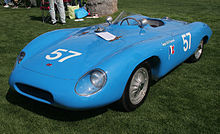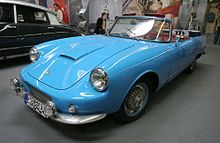- DB (car)
-
DB (until 1947 known as Deutsch-Bonnet) was a French automobile maker between 1938 and 1961, based in Champigny-sur-Marne near Paris. The firm was founded by Charles Deutsch and René Bonnet. Immediately before the war the partners concentrated on making light-weight racing cars, but a few years after the war, starting with the presentation of a Panhard based cabriolet at the 1950 Paris Motor Show, the company began to produce small road-going sports cars. By 1952 the company no longer had its own stand at the Paris motorshow, but one of their cars appeared as a star attraction on the large Panhard stand, reflecting the level of cooperation between the two businesses.[1]
Contents
Light-weight engineering
The business produced light sports cars, originally in steel but subsequently with fiberglass bodies mainly powered by Panhard flat-twin engines, most commonly of 610, 744, or 851 cc. Deutsch was a "theoretical engineer who had a natural instinct for aerodynamics," while Bonnet was a more "pragmatic mechanical engineer".[2]
The fiberglass bodies covered a tubular central beam chassis made from steel, with front wheel drive and four wheel independent suspension directly lifted from the Panhard donors.[3] Until 1952 all DBs had been for competition purposes only.
Racing origins
Deutsch and Bonnet had been promised a works drive in the 1936 French GP for sports cars, but when this failed to materialize they set about building their own racer.[2] The 1938 DB1 was a special, built using the remains of a Citroën Traction Avant 11CV. A series of numbered successors followed, with a DB4 in 1945 and a 2-liter DB5. Their two specials both placed in the first postwar race in France, in Paris in 1945. An open-wheeled DB7 appeared in 1947, after which the Automobiles Deutsch & Bonnet was officially formed.[3] Their early cars were all built using Citroën parts, but supply was troublesome and DB soon moved on to using Panhard technology.
DB was very active in competition especially in Le Mans 24 Hours.
Road cars
The steel-bodied 1952 "Mille Miles" (celebrating class victories at the Mille Miglia) was a mini-GT with a 65 hp Panhard two-cylinder; it was quickly followed by the Chausson-designed DB Coach in fibreglass. The HBR model (1954–1959) was the partners' most successful project to date, with several hundred of the little cars produced between 1954 and 1959.[1] This was followed by the LeMans (1958–1964). About 660 of the Mille Miles/Coach/HBR were built, and approximately 200 Le Mans. Later versions could be equipped with engines of 1 and 1.3 litres, and superchargers were also available. No two cars may have been alike, as they were built according to customer specifications from a wide range of options.
More racing success
Deutsch's very efficient and influential aerodynamic designs allowed DB race cars to reach impressive top speeds despite the small Panhard flat-twin engine. Deutsch and Bonnet disagreed whether they should build cars of front-wheel drive or mid-engined design. DB's received class victories at Le Mans (three times), Sebring (twice), and Mille Miglia (four times).[3] DB even managed an outright win in the handicapped 1954 Tourist Trophy sports car race.[2]
Disagreement and the end of the partnership
Charles Deutsch, wanting to stick to Panhard engines, left DB in 1961 to found his own firm (CD). Bonnet founded Automobiles René Bonnet, producing cars powered by Renault engines: this business was later to become part of Matra Automobiles. Deutsch ended up an engineering consultant.
References
- ^ a b "Automobilia". Toutes les voitures françaises 1953 (salon Paris oct 1952) (Paris: Histoire & collections) Nr. 19: Page 20. 2000.
- ^ a b c Mike Lawrence (1991). A to Z of Sports Cars. Bideford, Devon: Bay View Books. pp. 91–92. ISBN 1-870979-81-8.
- ^ a b c James M. Flammang (1994). Standard Catalog of Imported Cars, 1946-1990. Iola, WI: Krause Publications, Inc.. pp. 184–185. ISBN 0-87341-158-7.
External links
Categories:- Defunct motor vehicle manufacturers of France
- Sports car manufacturers
Wikimedia Foundation. 2010.


